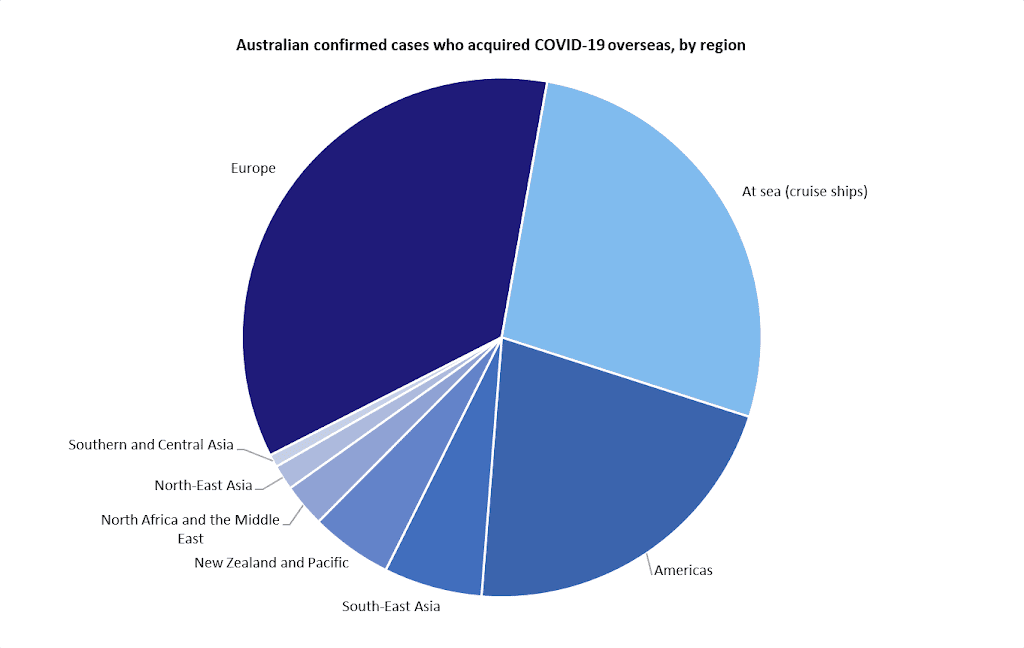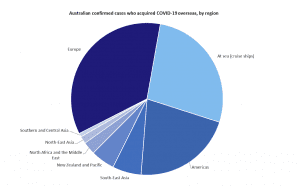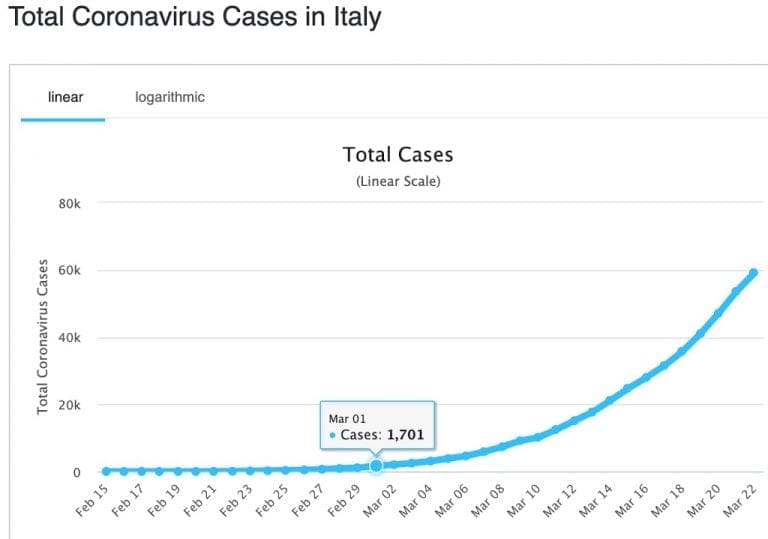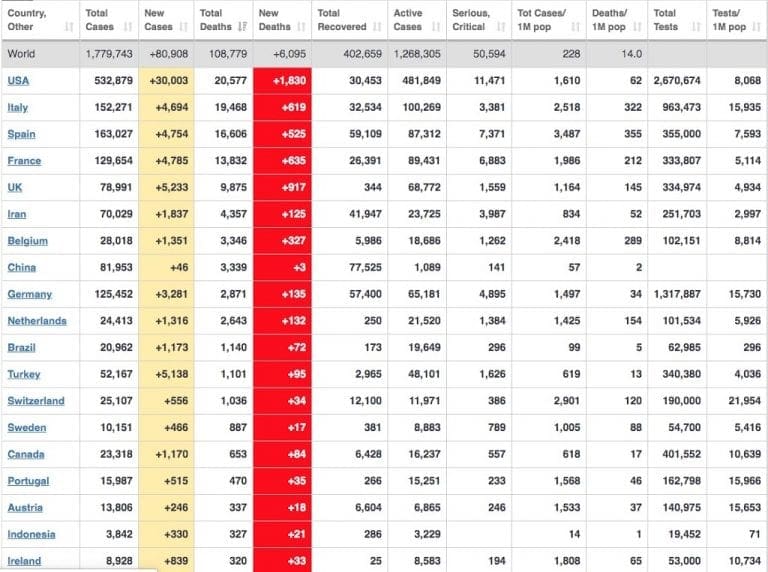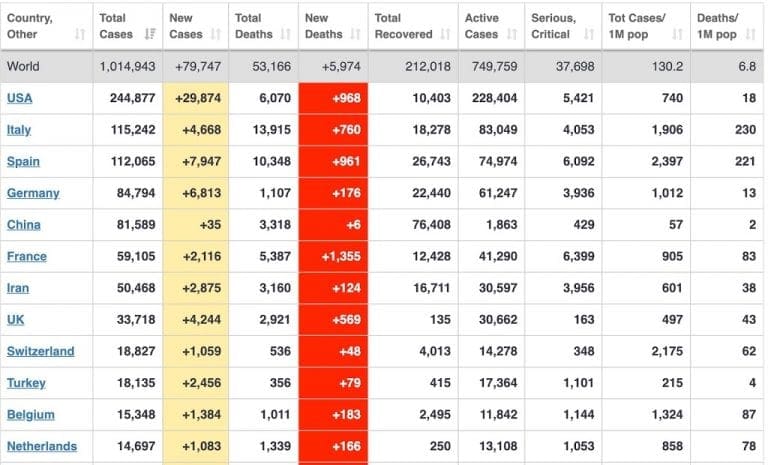COVID-19 Risks as at 31 March 2020
I’ve been asked if I could workout a ‘tipping point’ between doing nothing and locking down. At this stage, because we have been slow to react in all countries (except China, South Korea, Taiwan and Singapore) such an analysis is beyond me. I can undertake a ‘risk analysis’. I’ll be considering this from the position of Australia. Some might apply more widely.
First up a few very good videos to warm you up.
- This one from India with an excellent simulation.
- This from Italy with an interview of an ICU nurse.
- This from the UK on how the virus works.
- This article from the ABC is extremely good at explaining what I was trying to do with my earlier blogs.
- This article from the ABC on why you should stay home.
‘To conserve its remaining test kits’, for the last two weeks Australia has had a policy of testing only a very select sub-set of those attempting to be tested. People showing up with clear symptoms were not tested unless they had recently arrived from overseas or had known contact with a known case. So, infected people have been wandering around infecting more people. This stupid policy has now been marginally relaxed.
Australia’s data is unreliable. Australia has no idea how many infected cases it has. Published data wants to show we have a flattened curve. Australia reported just 201 new cases for yesterday. The real number will be closer to 1,500. We’ve had no good procedures in place to cause such a flattening. I am deeply suspicious that we will suddenly rebound to join Germany’s curve or worse.
What Australia claimed to do
- We’ve mainly been working on closing the gate as described in video ‘a’ above and trying to get 90% of the population to comply.
- However, for some unknown reason testing was restricted when it became apparent we needed to do more testing.
- Australia shut borders with the outside world on 19 March and also between most states on about 22 March (except NSW-Victoria border). We are allowing truck transport across borders but not holiday makers and grey nomads. These changes were implemented by individual states – without consulting the federal government.
- Preventing gatherings of people. Four square metres per person introduced 22 March. The number allowed gradually reduced to 10 (enforceable with on the spot fines in most states) and now down to 2. Exceptions are weddings (5 people), funerals (10). The restriction on weddings followed a few weddings being identified as hot sources of spread infections.
- Social distancing to 1.5 metres. This has been difficult to enforce.
- Extensive tracking of all cases has identified hot spots and dispersal points. But, not enough testing around those sites to find all cases.
- Australia got a huge shock on 18 March when 2,700 passengers were discharged from the Ruby Princess. I strongly suspect that outrage from this jolted the county into stronger compliance. Since then, we moved towards much stronger quarantine at borders.
- We have been lucky that our Prime Minister has not yet contracted the virus. This has meant that he has been available to be persuaded to take stronger action. He was pretty laissez faire to begin with. We’ve also been lucky that people could persuade him – whatever methods that took. However, he is still seeking to ‘spin’ everything to his own advantage and his statements are anything but clear.
Where did we get COVID-19 from?
Health risks
- Failure to be able to keep to a social distance of 1.5-2.5m. This together with washing hands with soap might be the simple methods we can use to control the spread of COVID-19 (see videos etc above). People will breach these simple rules and it will lead to more infection and deaths.
- Failure to shut the gate – as described in video ‘a’ above.
- Failure to test sufficiently. This looks to be the case in all countries except the 4 listed in the first para above. It is certainly the case in Australia. It means that we have no idea of the number of infected people wandering around infecting more people. Countries do not have the resources to test sufficiently, nor track huge hot spots and outbreaks and so have to resort to closing the gate. Australia has concentrated its efforts on jobs and economic policy and ignored testing – to save a bit of money.
- Complete lockdown worked in China, South Korea, Taiwan and Singapore. It has not worked elsewhere. It looks as though the best we can do is
- to try to get 80-90% of the population to keep completely away from each other – with a few exceptions.
- Prevent people travelling for whatever reason (again a few exceptions)
- Enforce quarantine when they do.
- In most of the world, people are not self-isolating or quarantining. Most countries don’t appear to be enforcing these requirements. The west scoffed at images from China of people being dragged away by people in PPE (Personal Protection Equipment) and reports of using phone tracking to locate people. In most countries, people can break quarantine with impunity.
- Lack of urgency. Epidemiologists and ABC’s Norman Swan are reporting that it takes about 14 days from the time an initiative is put in place and when we see a result. This is largely due to the lag in the development of symptoms from time of infection. A few examples are below. The message is ‘act very quickly, shut down as much as you can to prevent person-person contact and enforce social isolation – get at least 80% (or better 90%) of the population to self-isolate’.
- China very quickly moved off its exponential path. The first flattening change happened from about 27 January. Can we trace anything to about 13 January? I cannot see any intervention until 23 January when the central government stepped in and imposed a complete lockdown of Wuhan and other cities in Hubei. That certainly did the trick. Exponential growth was stopped and the graph changed shape. The next change in the China curve is a step change in 12 February when different testing (mobile CT scans and infra-red face scans for temperature) saw a sudden increase of > 14,000 new cases. It now looks as though China will not have more than 90,000 cases. China’s death toll is still increasing. However, it may max out at about 3,500. China’s experience in handling SARS has clearly informed this rapid decision and strong action. (As it did for South Korea, Singapore and Taiwan. The west ignored that experience.) Looking at China’s death curve, it looks as though it took at least 35 days after China’s shut down on 23 January until its number of deaths had flattened by about 27 February. About a month later China is still shut down with full quarantine of any arrivals from anywhere. China is clearly still very concerned that a single case could restart the whole epidemic. How does China reopen? And when can China return to ‘normal’ commerce and social interaction? Could be a while.
- Germany had been on an unimpeded exponential growth in cases until 21 March when it suddenly began a flatter path. I cannot see a corresponding action 14 days earlier. Germany did not begin to take decisive action until 16 March. Deaths in Germany is still on a steep exponential rise.
- Italy may have had a change at about 1 March. What did Italy do on about 16 February? After no action, on 22 February suddenly Italy imposed quarantine zones across northern Italy in ‘Red Zones’. Schools were closed. All public events cancelled. Religious services cancelled. Train services curtailed. Penalties from €206 to 3 months imprisonment. Since then, Italy’s curve looks to be heading for a maximum. It will not be many more days before we can estimate the maximum cases and deaths in Italy.
- France is still trending up. No end in sight.
- USA (very slow to act) cases is trending rapidly up (and appears to be accelerating and might top 1 million cases and one hundred thousand deaths).
- Spain had a very slight change about 13 March. Looking at 28 Feb I cannot see that Spain has done anything at all until about 13 March when it began closing shops (except food & necessities) & closure of ports and airports and railways. Spain could have 50,000+ deaths.
- UK – I cannot see any change in the curve. UK did nothing until 23 March. Early days. UK’s deaths are still climbing rapidly with no end in sight.
- Overwhelmed hospital medical capability. Italy’s experience allows us to see what can happen when ICUs are overwhelmed (see b above). Italy has reduced the age of people that they will consider for an ICU bed or ventilator. Video b above describes a drop to 70. It has subsequently reduced to 65 then to 60. Even then no one with any complicating secondary illness. Because people appear to need ICU beds/ventilators for long periods and many never get off them, instructions are given that ‘If no response in 7 days, move them along. We need the bed.’
- Grey nomads. In Australia, we are about to move into our winter. In winter, between 250,000 and 500,000 ‘grey nomads’ climb into their caravans and mobile homes and head north to warmer climes. Ie away from the cities where there are ICUs and medical facilities to beaches, creek beds and villages where there are none or one. Most of these ‘grey nomads’ are not young and do not believe in this ‘social isolation’ bullshit. They will gather in groups of 50 around campfires to get on the piss. Infrastructure in Australia is not set up to deal with this sudden need for ICUs to accommodate the sick grey nomads. Hence, state governments slammed borders shut about a month before the nomads usually leave having been prompted by hundreds of early arrivals. It might have been a bit late. Thousands left early.
- I was going to write a couple of simple formulae to estimate number of dead for any country. This article in the New York Times has a neat slider for US to show the result from various scenarios on number dead and hospitalised. It is not difficult to find settings where all those hospitalised die in very large numbers. Using those sliders, my estimate for the world is at least 140 million dead.
- India, Indonesia and Africa will almost certainly become sites of considerable infection and deaths. Methods of social isolation that may work in developed countries will not work in slums or in countries where shopping is done twice a day and food is not stored.
- US has become a significant infection and death hot spot.
Economic, Social and Political Risks
- Jobless, Rental & Homeless. Along with governments around the world, the Australian government has closed restaurants, coffee shops, music events, many non-essential businesses, etc. This has thrown hundreds of thousands (mainly casuals or from the gig economy) out of work with promises that they “will be looked after”. This is a huge political risk for governments. This group can see they have ‘taken the hit for the good of the community’ while the middle-class look on from their comfortable houses and jobs while hoarding food and toilet paper. The Australian government has taken quite extraordinary measures (for a conservative government) to attempt to make sure people thrown out of work are fed, housed, kept in touch with employers and will possibly have a job to go back to when this all finishes. Conservative looking a bit pink – well just a bit.
- Schools. A rock and a hard place or an admission that the real purpose of schools is to babysit kids so that their parents can be economic contributors to the community.
View 1. “Schools should close because social distancing is impossible and they will become sources of infection that will spread throughout the community – especially to parents and elderly grandparents.”
View 2 .”We need our schools open so the children’s parents can keep going to work – to a. contribute to the economy and b. to keep essential services going”. And “Singapore has not shut its schools”. That’s right they have not. However, every child has its temperature taken several times a day looking for signs of fever. We don’t do that – ‘can’t be bothered’. “Wishin’ n hopin'”. This is a true health/economic trade off. Will it also be political? - US vs China. This is an extreme risk to the world. China managed to get its infection under control and will possibly (within a few months) be able to get its economy and exports back in order. The US is heading towards a basket case with no sign of recovery, increasing death and chaos. Trump is already blaming China for US’s difficulties and is stoking the xenophobia fires. I’m not going to be surprised if the US launches a shooting war against China. It has already launched a trade war and after COVID-19 and with Trump needing to ramp up fear and hatred from his ‘base’, expect the shooting to start.
- Looting, home invasion, riot. These become risks if people are without food and housing when their neighbours have both. US citizens are, of course, buying guns. Be prepared. This hooks up with the political risk of forcing one chunk of the population to take the hit while protecting the better off who escape unscathed. Chaos is likely.
- Cruise ships. These have turned out to be floating COVID-19 infection factories. Now the passengers want off and countries are refusing to allow the ships to dock – even to refuel. A frisson has developed between countries wanting to get their countrymen home and countries everywhere wanting to destroy these floating deathtraps. This will continue as a diplomatic issue as countries press to get their citizens home – but where to disembark? All passengers disembarked from cruise ships must be securely quarantined.
- ABC. The ABC (public broadcaster Australian Broadcasting Corporation) is ‘trusted most by nearly ten times as many people as the Murdoch Press’. I strongly suspect that the ABC (and its outspoken Normal Swan) nagging at the government has been one of the levers that has persuaded the Morrison government to act (and even act to help people). I also suspect that the ABC will be severely punished (for being right, being accurate, changing public opinion, getting the government to change). More budget cuts.
- Supply lines.
- Regional centres such as Wagga reply on regional airlines to transport freight and medical personnel. Many medical specialists come for weekly clinics. This applies to regional centres all over the country. If airlines close or cease running to regional centres, those economies and health centres will collapse.
- Even keeping trucks running means that they have to have places to stop, eat and shower. Because most other road traffic has halted, many ‘truck stops’ have closed.
- Our train services have been allowed to completely degrade and barely function. They are no substitute for long distance road transport.
- Product lines. In many cases, we need to make certain that full product lines are kept running. Surprisingly this is more difficult that I had thought. For example, toilet paper – an old favourite and the spread of COVID-19 around the world can be tracked by the date each country’s shelves are stripped of toilet paper (Germany 29 Feb, Canada 12 March, UK 18 March). Australia makes its own toilet paper. However, its manufacture is deeply embedded as part of forestry products. It is a secondary stream that comes from making floorboards. If you want toilet paper, we have to keep cutting and milling timber to make floorboards.
- Trade lines. Many of the items we need in Australia come from overseas. This certainly includes medical items – ventilators, PPEs. We need trade/shipping/air freight routes open so that supplies continue to arrive. As manufacturing has closed down with the spread of COVID-19, so distribution of products around the world has dropped. It does look as though China will open its manufacturing with products in demand from COVID-19 infected countries. That just might irritate Mr Trump and push ‘3’ above.
- Alcohol. Alcohol will be consumed in vast quantities during the shutdown. It might have a few long term health effects as well as pushing items ’11’ and ’12’ below.
- Family abuse. People are being shut up with each other. This has been difficult at the best of times. With a bit of stress and alcohol, we can expect increased beating and abuse.
- Population boom. In the past, we’ve only needed a power failure to cause an increase in births. Locked up for months, bored, fuelled by piss. What could possibly go wrong? Look to another ‘baby boom’.
- Depression. Isolated, jobless, worthless, hopeless. Depression services will be overwhelmed.
- COVID refugees. We can expect refugees from countries with failing health systems, failing economies and countries in chaos. All refugees would have to be strictly quarantined.
- A different world. We will be isolated in our houses/apartments/villas etc for up to six months. We will have learned to work from home, socialize remotely, do without cafes/coffee shops/driving/commuting. Life will not be the same on the other side.
- Remote sex. Think about it – on perhaps not.
